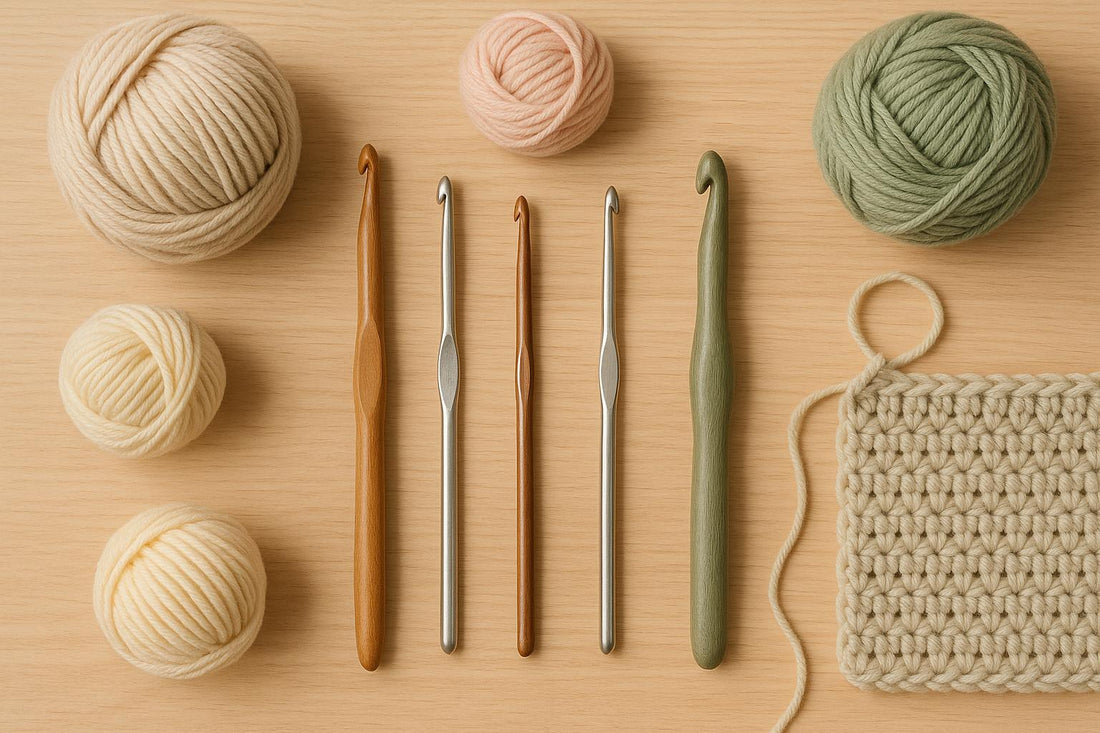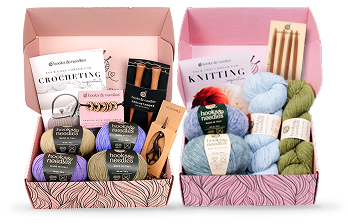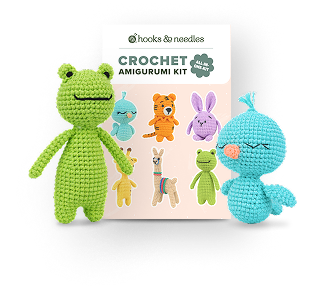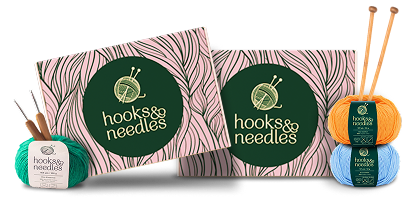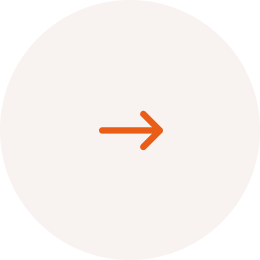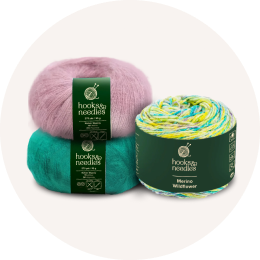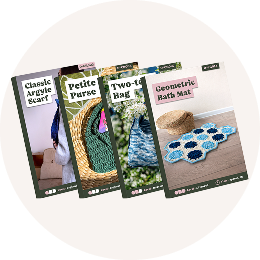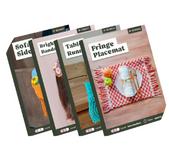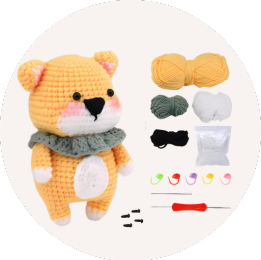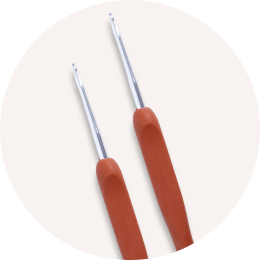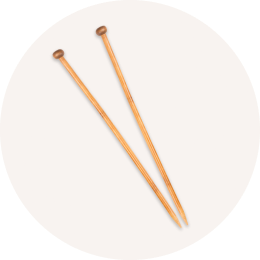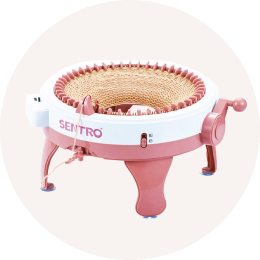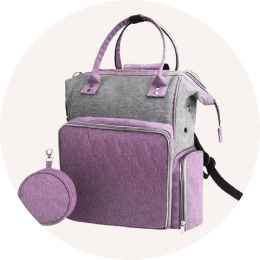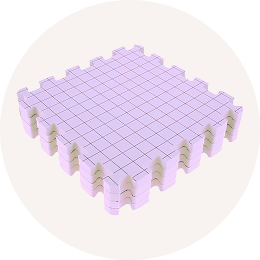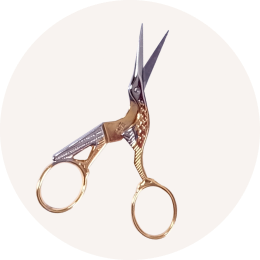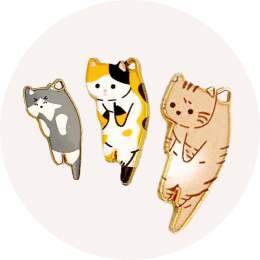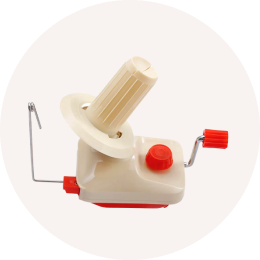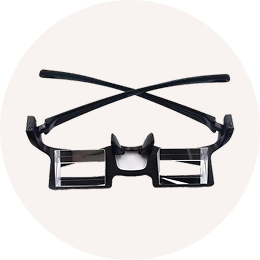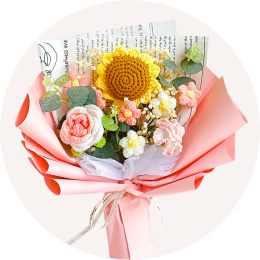Choosing the correct crochet hook size is key to creating projects that look great and feel right. The size of your hook affects stitch size, fabric texture, and overall project outcome. Here’s what you need to know:
- Yarn Weight Matters: Different yarn weights pair with specific hook sizes. For example, lace yarn works with tiny hooks (1.4–2.25mm), while jumbo yarn needs large hooks (15mm+).
- Project Type Guides You: Tight stitches suit amigurumi, while loose stitches work better for flowing scarves or shawls.
- Your Tension Plays a Role: If you crochet tightly, go up a hook size. If you crochet loosely, size down.
- Gauge Testing is Essential: Always create a swatch to ensure your stitches match the pattern’s requirements.
Pro Tip: Use the millimeter size (e.g., 5.0mm) on hooks for consistency across brands and patterns. This avoids confusion with US or UK sizing systems.
Yarn Weight and Crochet Hook Sizing Guide (For Beginners)
How Crochet Hook Sizing Works
Choosing the right crochet hook size is crucial for matching your yarn's weight and achieving the desired results for your project. Crochet hooks often come with labels like "G-6" or "5.0mm", which can seem confusing at first, but they follow specific sizing systems.
US Hook Sizes vs. Metric Measurements
In the United States, crochet hooks use a dual-labeling system that combines letters and numbers with metric measurements. For example, you might see "B-1 (2.25mm)" or "H-8 (5.0mm)." The letter and number represent the traditional US system, while the millimeter measurement in parentheses indicates the exact diameter of the hook shaft.
The US system starts with smaller hooks labeled with letters from B to S, paired with numbers that generally increase as the hook size gets larger. For instance, a B-1 hook is much smaller than an N-15 hook. However, not every letter is used, and the progression isn't perfectly linear.
The millimeter measurement, on the other hand, is straightforward and precise. It tells you the diameter of the hook shaft, ranging from tiny 2.25mm hooks for delicate thread work to jumbo 25mm hooks for super bulky yarns. This directly impacts your stitches - larger diameters create bigger stitches and looser fabrics.
Understanding millimeter sizes can help you maintain consistency across brands. For example, while one brand's "G" hook might feel slightly different from another's, a 4.0mm hook will always be 4.0mm, no matter the manufacturer. This is especially helpful when switching hooks mid-project or using patterns from different sources.
This knowledge lays the groundwork for pairing hooks with yarn weights and project requirements, which will be explored further in later sections.
Converting Between US, UK, and Metric Systems
Things can get tricky when working with patterns from different countries, as the US and UK developed separate hook sizing systems. These systems often overlap but also differ, which can confuse even seasoned crocheters.
In the UK, hook sizes use different labels and numbering. For example, what Americans call a "G-6 (4.0mm)" hook might be labeled as an "8 (4.0mm)" hook in UK patterns. Despite the differences in naming, the millimeter measurement remains consistent.
Here’s a conversion chart to help you match US, metric, and UK hook sizes:
| US Size | Metric (mm) | UK Size |
|---|---|---|
| B-1 | 2.25 | 13 |
| C-2 | 2.75 | 12 |
| D-3 | 3.25 | 10 |
| E-4 | 3.5 | 9 |
| F-5 | 3.75 | – |
| G-6 | 4.0 | 8 |
| H-8 | 5.0 | 6 |
| I-9 | 5.5 | 5 |
| J-10 | 6.0 | 4 |
When working with international patterns, the safest bet is to rely on the millimeter measurement. If a pattern specifies a 6mm hook, use whichever hook you have that matches that measurement, regardless of its US or UK label. This eliminates guesswork and ensures your gauge aligns with the pattern designer's instructions.
While many modern patterns include both sizing systems for clarity, older patterns may only use one. To avoid errors, always double-check the millimeter equivalents rather than relying solely on letter or number conversions. This extra step can save you a lot of frustration down the line.
Matching Yarn Weight to Hook Size
The yarn weight system is a handy guide that helps you pair your yarn with the right hook size. By following these standardized categories, you can achieve consistent results and make your crochet projects more enjoyable.
Yarn Weight Categories and Hook Size Recommendations
Yarn weights are grouped into categories numbered from 0 to 7. Each category corresponds to a specific range of hook sizes, with thicker yarns requiring larger hooks to create properly sized stitches.
- Lace weight yarn (Category 0): The thinnest yarn, paired with hooks ranging from 1.4 mm to 2.25 mm (B-1). Perfect for delicate patterns like doilies, often worked with steel hooks for precision.
- Super fine yarns (Category 1): Includes fingering and sock yarns, best matched with 2.25 mm to 3.5 mm hooks (B-1 to E-4). Ideal for baby items and lightweight garments with detailed stitch work.
- Fine yarns (Category 2): Sport weight yarns that work well with 3.5 mm to 4.5 mm hooks (E-4 to size 7). Popular for children’s clothing and accessories.
- Light worsted or DK yarns (Category 3): Use 4.5 mm to 5.5 mm hooks (size 7 to I-9). A favorite for crafting sweaters, blankets, and home decor.
- Medium weight yarns (Category 4): Includes worsted and aran yarns, often recommended for beginners. Pair with 5.5 mm to 6.5 mm hooks (I-9 to K-10.5) for easy handling and visible stitches.
- Bulky yarns (Category 5): Requires larger hooks, ranging from 6.5 mm to 9 mm (K-10.5 to M-13). Great for quick projects like winter accessories.
- Super bulky yarns (Category 6): Matches with hooks from 9 mm to 15 mm (M-13 to Q and beyond). Perfect for creating chunky, bold pieces in record time.
- Jumbo yarns (Category 7): Needs hooks 15 mm and larger, ideal for oversized blankets and dramatic home decor items.
Here’s a quick reference table to simplify your hook and yarn pairing:
| Yarn Weight | Category Number | Hook Size Range (mm) | US Hook Range | Typical Gauge (sc/inch) |
|---|---|---|---|---|
| Lace | 0 | 1.4 – 2.25 | Steel – B-1 | 8+ |
| Super Fine | 1 | 2.25 – 3.5 | B-1 – E-4 | 5.25 – 8 |
| Fine | 2 | 3.5 – 4.5 | E-4 – 7 | 4 – 5 |
| Light/DK | 3 | 4.5 – 5.5 | 7 – I-9 | 3 – 4.25 |
| Medium/Worsted | 4 | 5.5 – 6.5 | I-9 – K-10.5 | 2.75 – 3.5 |
| Bulky | 5 | 6.5 – 9 | K-10.5 – M-13 | 2 – 2.75 |
| Super Bulky | 6 | 9 – 15 | M-13 – Q | 1.75 – 2.25 |
| Jumbo | 7 | 15+ | 15+ and larger | Varies |
These guidelines are a starting point, but you can adjust based on the yarn’s behavior and your project’s needs.
Tips for Pairing Hooks and Yarn
While standard size recommendations are helpful, other factors can influence your hook choice. The fiber content of your yarn, for instance, plays a big role in how it interacts with different hooks:
- Cotton yarns: These have little stretch, so using a slightly larger hook can create a softer fabric.
- Wool yarns: Naturally elastic, they work well with the suggested hook sizes or even smaller ones for more structured results.
- Bamboo, silk, or rayon fibers: These slippery yarns are easier to manage with wooden or bamboo hooks, which provide better grip.
- Synthetic blends: Acrylic yarns typically follow standard recommendations, but a larger hook can prevent overly dense stitches.
Your project’s purpose also matters. For example, amigurumi and stuffed toys require tight stitches to keep the stuffing hidden, so a smaller hook is often better. On the other hand, shawls and scarves benefit from drape and flow, making larger hooks a good choice for softer, more fluid fabrics.
Most yarn labels suggest a hook size, but it’s always wise to create a gauge swatch first. Testing your tension, stitch pattern, and desired fabric texture will help you fine-tune your hook choice. Taking this extra step can save you from headaches later on!
How Project Type and Stitch Tension Affect Hook Choice
Selecting the right crochet hook isn’t just about matching it to your yarn weight. Your project’s purpose and your personal stitching style play a huge role in determining the perfect hook size. The texture and feel of the fabric you want to create are key factors to consider.
How Project Type Affects Hook Selection
The type of project you’re working on can drastically influence your hook choice. Here’s how different projects might guide your decision:
- Amigurumi and stuffed toys need tight, snug stitches to keep the stuffing securely inside. To achieve this, use a hook that’s 1–2 sizes smaller than what’s recommended on the yarn label. For worsted weight yarn, this tighter gauge ensures a sturdy fabric that holds its shape.
- Blankets and afghans vary depending on their use. Baby blankets often call for a softer, more flexible fabric with good drape, so using the recommended hook size - or even going one size larger - can work well. For adult throws that need to withstand wear and tear, sticking to the standard hook size helps maintain durability and prevent stretching.
- Garments require a balance between fit and drape. For fitted sweaters and cardigans, hooks that produce minimal stretch - either the recommended size or slightly smaller - are ideal. On the other hand, flowy tops and summer cardigans benefit from looser stitches, which you can achieve by using a hook one size larger than suggested.
- Dishcloths and washcloths need to be durable and able to withstand repeated use and washing. A hook one size smaller than recommended helps create dense, tight stitches that hold up over time and scrub effectively.
- Lacy shawls and decorative items shine with excellent stitch definition and a flowing texture. To achieve this, use hooks 1–2 sizes larger than the standard recommendation, which enhances the airy, open look of lace patterns.
Once you’ve matched the hook to your project type, your natural stitch tension will further refine your choice.
Adjusting for Stitch Tension and Texture
Your natural stitching style - whether tight or loose - can make a big difference in how your finished project looks and feels. Adjusting your hook size accordingly helps you achieve the desired results.
- Tight crocheters tend to produce smaller stitches and denser fabric. If this sounds like you, consider using a larger hook - 1–2 sizes bigger than suggested - to make your work more manageable and prevent hand fatigue.
- Loose crocheters often deal with fabric that feels too open or lacks structure. In this case, a smaller hook - 1–2 sizes smaller than recommended - can help tighten up your stitches and improve stitch definition.
The stitch pattern you’re working with also plays a role:
- Textured stitches like bobbles, popcorns, or cables can make the fabric feel tighter, so a slightly larger hook can help maintain flexibility.
- Simple stitches like single crochet or half double crochet generally work well with standard hook sizes.
- Open patterns with lots of chain spaces benefit from larger hooks to enhance the lacy, airy effect.
Finally, think about the drape you want for your finished piece. Structured items like bags, baskets, or home decor need firm fabric, which smaller hooks can create. For flowing garments and accessories, larger hooks produce softer, more flexible stitches that add movement.
Experimenting with different hook sizes is the best way to refine your consistency and find what works for both your project and your personal style.
sbb-itb-f7119e8
Testing Gauge and Adjusting Hook Size
When it comes to pairing hooks and yarn, testing your gauge is the key to ensuring your project turns out just right. Gauge is all about the number of stitches and rows you can fit into an inch, and it plays a big role in determining the final size and fit of your work. Everyone crochets a little differently - some with tight stitches, others with a looser hand - so taking the time to test your gauge can save you from a lot of frustration later on.
Skipping this step might lead to a sweater that doesn’t fit, a blanket that’s off in size, or a hat that doesn’t hold its shape. Spending a little time on a gauge swatch now can save you hours of redoing work down the line.
How to Test Gauge with a Swatch
To test your gauge properly, aim to replicate the conditions of your project as closely as possible.
Start by crocheting a swatch that’s at least 50% larger than the area required for gauge testing. Why? The edges of your swatch can distort slightly, so having extra space helps you get an accurate reading from the center.
Use the exact yarn, hook, and stitch pattern specified in your project. If your pattern calls for single crochet, don’t test your gauge using double crochet - it won’t give you the same results. The type of stitch directly impacts the fabric’s density and measurements.
Once your swatch is complete, it’s time to block it. Blocking helps the yarn settle into its final shape, which is especially important because many yarns can stretch or shrink during this process. If you’re wet blocking, soak the swatch in lukewarm water, then lay it flat to dry. For steam blocking, hover a steam iron above the fabric without touching it. Use the same blocking method you plan to use for your finished project to keep everything consistent.
After the swatch is completely dry, lay it flat and mark a 4-inch square with a ruler. Count the stitches within this square, including any partial stitches. Repeat the process to count the rows vertically. Be precise - just half a stitch off can throw off the entire width of a finished garment.
Once you’ve measured your gauge, you can adjust your hook size if needed to get the perfect match.
Adjusting Hook Size to Match Gauge
If your gauge doesn’t line up with the pattern, changing your hook size is the easiest way to fix it. Here’s how it works: larger hooks create fewer stitches per inch, while smaller hooks create more stitches per inch.
- If you’re getting too many stitches per inch, switch to a larger hook, like moving from an H-8 (5.0mm) to an I-9 (5.5mm).
- If you have fewer stitches than required, your stitches are too loose. Try a smaller hook, such as going from an H-8 (5.0mm) to a G-6 (4.0mm).
Keep testing until your gauge matches the pattern. It’s not uncommon to go through three or four hook sizes, especially with unfamiliar yarns or intricate stitch patterns.
Don’t forget to check both your stitch gauge and row gauge. The stitch gauge affects the width of your project, while the row gauge determines the length. If your row count is off but your stitch count is correct, you might need to adjust your technique slightly. Taller stitches, like double crochet, tend to be more sensitive to tension changes than shorter ones.
As you test, keep detailed notes about the hook sizes you try and the results you get. Many crocheters find it helpful to maintain a gauge journal, where they record swatches, measurements, and hook sizes. This can be a lifesaver for future projects using similar materials.
Finally, don’t just check your gauge at the start - keep an eye on it throughout your project, especially after the first few inches. If you notice your tension changing, you can make small adjustments to stay consistent. A little attention to detail goes a long way in creating a polished, professional-looking piece.
Common Mistakes and Expert Tips
Even experienced crocheters can stumble when it comes to picking the right hook size. Mistakes in this area can cost you time, yarn, and patience, but learning from these missteps - and following expert advice - can make a world of difference. Building on the earlier discussion of gauge and tension, here are some common pitfalls to avoid and tips to perfect your hook selection.
Common Hook Selection Mistakes
One of the most frequent errors is relying solely on the yarn label’s hook recommendation. While the label might suggest an H-8 (5.0mm) hook, that’s just a starting point. Your personal crochet style, the stitch pattern, and the desired drape of your project all influence the ideal hook size. For example, a structured bag might require a G-6 (4.0mm), while a flowing scarf might call for an I-9 (5.5mm).
Another common issue is assuming all hooks of the same size are identical. A US H-8 hook is supposed to measure 5.0mm, but slight manufacturing differences can result in hooks that are 4.8mm or 5.2mm instead. These small variations can have a big impact on your gauge, especially in larger projects. Always check the millimeter measurement etched on your hook rather than relying solely on the letter size.
Switching hook materials mid-project is another trap. Different materials - such as aluminum, bamboo, or plastic - affect how yarn glides and can change your tension. If you switch from an aluminum H-8 to a bamboo H-8, for instance, your stitches might suddenly feel tighter or looser. Always test your gauge again when changing hook materials.
Overlooking how yarn fiber interacts with hook size is a mistake that can lead to disappointing results. Natural fibers like cotton and wool behave differently than synthetic blends. Cotton, for instance, lacks the stretch of wool and often needs a larger hook than the label suggests to avoid creating stiff, dense fabric. On the other hand, using too large a hook with acrylic yarn can make your project lose structure and feel overly loose.
Finally, using the wrong hook size for specific techniques can derail your project. Decorative stitches like cables, bobbles, and textured patterns often require a different hook size than the main project. Many patterns don’t clearly note these adjustments, leaving crocheters to continue with their original hook and unintentionally compromise the look of the design.
Expert Tips for Perfect Hook Selection
To avoid these pitfalls, consider these tried-and-true tips from crochet experts:
- Start with a gauge swatch. This is non-negotiable for achieving the right look and feel. For instance, a dishcloth should be dense enough to absorb water but not so stiff that it feels like cardboard. A scarf, on the other hand, should drape beautifully rather than standing rigid.
- Keep a project journal. Jot down the yarn brand, weight, fiber content, hook size, and project type. Over time, this record becomes a valuable resource, helping you identify patterns in your crocheting style and making future projects easier to plan.
- Invest in a hook gauge tool. These small tools let you measure your hook’s true size in millimeters. This is especially useful if you use vintage hooks or have a collection from various manufacturers, where sizing inconsistencies are more likely.
- Match your hook size to the project’s purpose. A baby blanket should be soft and cozy, which might mean going up a hook size for a looser gauge. A market bag, however, needs durability and structure, requiring a smaller hook for tighter stitches. For a summer top, a larger hook can create the breathable, airy fabric you want.
- Check your gauge at different times. Your tension can fluctuate based on factors like stress, fatigue, or even the temperature. If you’re working on a long-term project, periodically test your gauge to ensure it stays consistent.
- Trust the "fabric hand" test. Beyond the numbers, the swatch should feel right for the project. A sweater should have some stretch and bounce, while a tote bag should feel firm and sturdy. If the gauge is technically correct but the fabric doesn’t feel suitable, listen to your instincts and adjust your hook size.
- When in doubt, size up. A slightly loose gauge is easier to correct with blocking or stitch adjustments than overly tight fabric, which can be hard to fix. Loose fabric can often be shaped to your liking, but dense, stiff fabric may never achieve the desired effect.
Conclusion: Key Points for Choosing the Right Crochet Hook Size
Choosing the right crochet hook size can turn uncertainty into confidence, paving the way for precise and creative projects. The secret lies in understanding how hook size affects stitch size, which directly impacts your project’s dimensions, texture, and overall drape. These principles, outlined earlier, are essential for making informed decisions.
Start with the yarn label’s suggested hook size, but don’t stop there - fine-tune your choice based on your personal tension, the stitch pattern, and the purpose of your project. For example, the approach for a tightly woven dishcloth will differ from that of a breezy summer cardigan, even if both use the same yarn weight. Refer back to the earlier tips on sizing, yarn compatibility, and gauge for a well-rounded strategy.
Always test your gauge with a small swatch before diving into your project. This quick step ensures that your chosen hook and yarn combination creates the fabric you envision. It’s easier to make adjustments early than to redo an entire project later.
Keep in mind the basic rule: larger hooks work better with thicker yarns, while smaller hooks suit finer yarns. Pay attention to how the fabric feels in your hands and adjust accordingly. The material of your hook - whether aluminum, steel, plastic, or bamboo - also plays a role in your comfort and stitch consistency. Don’t hesitate to experiment with different materials to find the one that feels just right for you and your yarn.
"You can crochet with any fine, flexible, continuous material that you can wrap around a crochet hook." - Kim and Pulvermahker
This freedom extends to your hook selection. Trust your instincts about how the fabric should feel, and keep a project journal to note what works best for you. If you’re ever unsure, choosing a slightly larger hook can often make your project more manageable than using one that’s too small.
FAQs
How can I figure out the right crochet hook size if I don’t have the one recommended for my yarn?
If you don’t have the recommended hook size for your yarn, take a look at the yarn label to find its weight category (like lace, worsted, or bulky). Each weight is usually associated with a range of hook sizes, which you can easily find in crochet guides or online resources.
That said, the suggested hook size is just a guideline. To make sure your project comes out the way you want, you’ll need to check your gauge - this refers to how many stitches and rows fit into an inch. If your gauge doesn’t match what the pattern calls for, try using a larger or smaller hook until it does. This step is key to getting the right tension and achieving the look you’re aiming for.
Why isn’t my crochet project turning out right, even after checking my gauge?
If your crochet project isn’t turning out quite right even after testing your gauge, don’t worry - there are a few things you can try to get back on track:
- Check your stitches carefully. Ensure you’re placing your hook in the correct chain or stitch, particularly at the beginning of rows or rounds. Misplaced stitches can throw off your entire project.
- Pay attention to your tension. Uneven tension can make your work too tight or too loose. Take some time to practice keeping your tension consistent as you crochet.
- Try a different hook size. If your gauge swatch came out smaller than needed, switch to a larger hook. If it’s too big, opt for a smaller one.
- Evaluate your yarn choice. The weight and type of yarn can affect your gauge significantly. Double-check that your yarn matches the recommendations in your pattern.
Making small tweaks like these can go a long way toward achieving the results you’re aiming for with your crochet project.
Do I need to use a different crochet hook for each type of yarn?
Yes, choosing the correct crochet hook size for your yarn is key to achieving the best results. Yarn weights like worsted or bulky are designed to work with specific hook sizes, ensuring your stitches have the right tension and your project looks as intended. Using the wrong hook can throw off your tension, alter the appearance of your work, and even make the yarn harder to handle.
To find the right hook, start by checking the yarn label - it usually lists the recommended size. You can also consult a crochet hook size chart for guidance. Before diving into your project, take a moment to test your gauge. This step helps ensure your stitches align with the pattern's requirements. The right hook makes all the difference in setting your project up for success!
